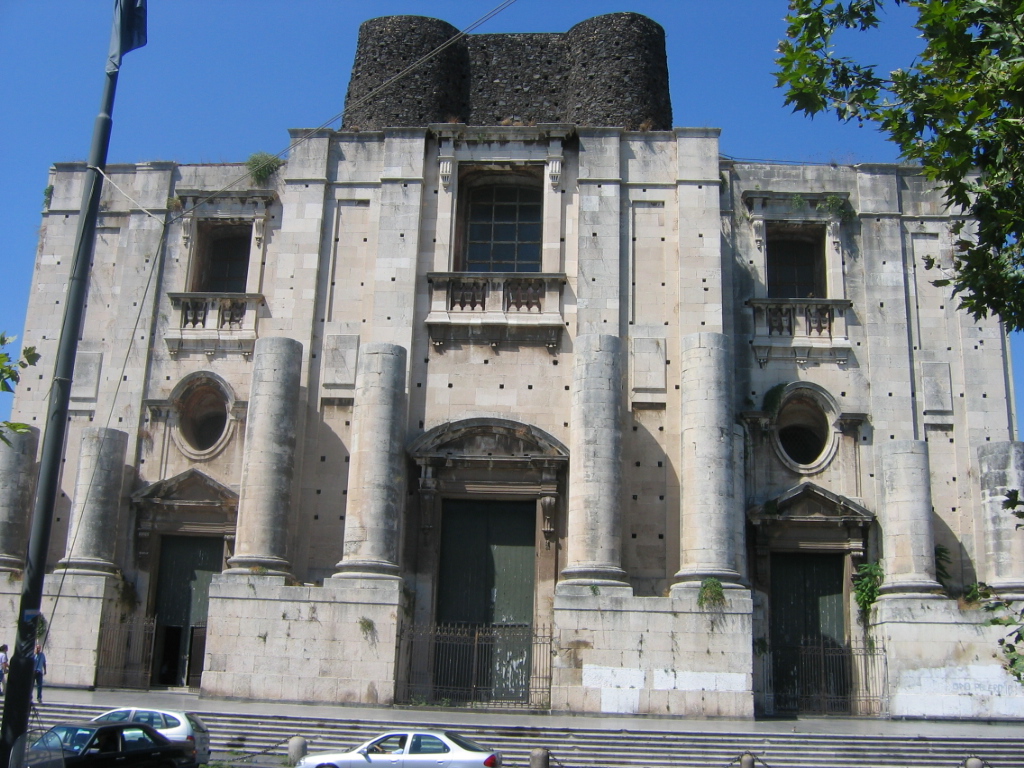San Nicolò L'Arena, Catania on:
[Wikipedia]
[Google]
[Amazon]
 San Nicolò l'Arena is the title of both the
San Nicolò l'Arena is the title of both the
Comune of Catania
entry on church. *''St Gregory'' by
San Nicolò l'Arena (Catania) - 30 12 2019 15.jpg, ''Nativity'' (1792) by Stefano Tofanelli
San Nicolò l'Arena (Catania) - 30 12 2019 21.jpg, ''Martyrdom of St Andrew'' (1805) by Ferdinando Boudard
San Nicolò l'Arena (Catania) - 30 12 2019 18.jpg, ''Martyrdom of St Agatha'' (1784) by Mariano Rossi
San Nicolò l'Arena (Catania) - 30 12 2019 03.jpg, ''St Gregory the Great sends St Augustine to apostolize England'' (1829) by Vincenzo Cammuccini
San Nicolò l'Arena (Catania) - 30 12 2019 04.jpg, ''Decollation of St John the Baptist'' (1810) by Stefano Tofanelli
 San Nicolò l'Arena is the title of both the
San Nicolò l'Arena is the title of both the Roman Catholic
The Catholic Church (), also known as the Roman Catholic Church, is the largest Christian church, with 1.27 to 1.41 billion baptized Catholics worldwide as of 2025. It is among the world's oldest and largest international institut ...
church and its adjacent and enormous Benedictine
The Benedictines, officially the Order of Saint Benedict (, abbreviated as O.S.B. or OSB), are a mainly contemplative monastic order of the Catholic Church for men and for women who follow the Rule of Saint Benedict. Initiated in 529, th ...
monastery ( Monastery of San Nicolò l'Arena) in the city of Catania
Catania (, , , Sicilian and ) is the second-largest municipality on Sicily, after Palermo, both by area and by population. Despite being the second city of the island, Catania is the center of the most densely populated Sicilian conurbation, wh ...
, Sicily
Sicily (Italian language, Italian and ), officially the Sicilian Region (), is an island in the central Mediterranean Sea, south of the Italian Peninsula in continental Europe and is one of the 20 regions of Italy, regions of Italy. With 4. ...
, southern Italy
Italy, officially the Italian Republic, is a country in Southern Europe, Southern and Western Europe, Western Europe. It consists of Italian Peninsula, a peninsula that extends into the Mediterranean Sea, with the Alps on its northern land b ...
. The facade of the church faces Piazza Dante.
History and description
The construction of this church begun in 1687, using designs of Giovanni Battista Contini, was interrupted by the profound effects of the1693 Sicily earthquake
The 1693 Sicily earthquake was a natural disaster that struck parts of southern Italy near Sicily, then a territory part of the Crown of Aragon by the Kings of Spain Calabria and Malta, on 11 January at around 21:00 local time. This earthquake was ...
. Reconstruction began in the 17th-century under different architects, including Francesco Battaglia and Stefano Ittar
Stefano Ittar (March 15, 1724 – January 18, 1790) was a Polish-Italian architect.
Biography
Ittar was born in Owrucz (then in the Polish–Lithuanian Commonwealth, now in Ukraine), where his father, a member of one of Italy's aristocratic f ...
, but the facade was never finished, and presently has a surreal appearance with half-complete columns, and riddled with holes meant to hold affix marble facing. The dome was completed in 1796 by Ittar. The wide interior has massive pilasters
In architecture, a pilaster is both a load-bearing section of thickened wall or column integrated into a wall, and a purely decorative element in classical architecture which gives the appearance of a supporting column and articulates an ext ...
and three naves. The main altar is surrounded by wooden choir stalls for the monks; the latter were carved by Nicolò Bagnasco. The main organ, still functioning was completed by abate Donato del Piano.
On the church Transept
A transept (with two semitransepts) is a transverse part of any building, which lies across the main body of the building. In cruciform ("cross-shaped") cruciform plan, churches, in particular within the Romanesque architecture, Romanesque a ...
floor is a sundial completed in 1841 by Wolfrang Sartorius, Baron of Waltershausen, of Göttingen, and professor Christian Peters from Flensburg.
Among the altarpieces in the church are:entry on church. *''St Gregory'' by
Vincenzo Camuccini
Vincenzo Camuccini (22 February 1771 – 2 September 1844) was an Italian Neoclassicism, Neoclassical painter. He was considered the premier academic painter of his time in Rome.
Biography
Early life and education
Camuccini was born in Rome, ...
(1st altar on right)
*''St Joseph'' by Mariano Rossi
Mariano Rossi (7 December 1731 - 24 October 1807) was an Italian painter, persisting in what had become an anachronistic Rococo style amid an ascendant neoclassical environment. His placement legions of figures in a complex scenography and quadr ...
(3rd altar on right)
*''Martyrdom of Saints Placido and Flavia'' by Placido Campolo (right transept)
*''St Benedict and Saints Placido and Mauro'' by Antonio Cavallucci
Antonio Cavallucci (21 August 1752 – 18 November 1795) was an eighteenth-century Italian painter of religious scenes and portraits.
Biography
Cavallucci was born in Sermoneta in the Lazio. His artistic talents were recognized in an early stag ...
(left transept)
*''Martyrdom of Sainte Agatha'' by Mariano Rossi
Mariano Rossi (7 December 1731 - 24 October 1807) was an Italian painter, persisting in what had become an anachronistic Rococo style amid an ascendant neoclassical environment. His placement legions of figures in a complex scenography and quadr ...
(3rd altar on left)
Gallery of Altarpieces
References
{{DEFAULTSORT:Nicolo l'Arena 18th-century Roman Catholic church buildings in Italy Roman Catholic churches in Catania